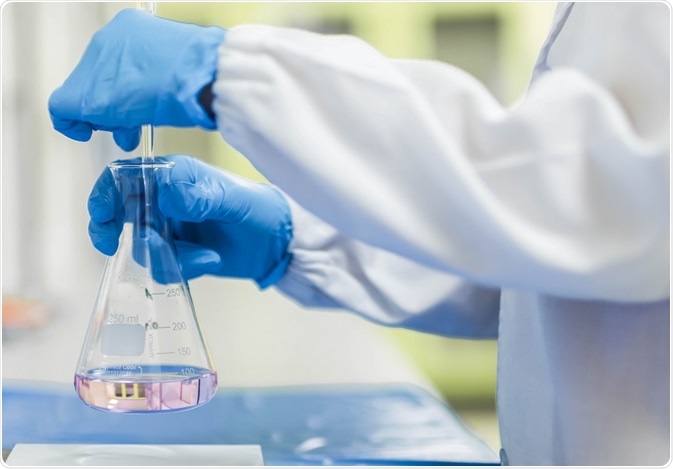Abstract
This experiment aims to determine the exact molarity of a sodium carbonate (Na2CO3) solution volumetrically using a standard solution of known concentration.
Introduction
The molarity of a solution indicates the number of moles of solute dissolved per liter of solution. Volumetric analysis involves the measurement of volumes to determine the concentration of a substance. In this experiment, the exact molarity of a Na2CO3 solution will be determined by titrating it against a standard solution of known concentration, typically hydrochloric acid (HCl).
Details of the Experiment
Procedure
- Prepare a standard solution of HCl of known concentration.
- Using a pipette, measure a known volume of the Na2CO3 solution into a conical flask.
- Add a few drops of phenolphthalein indicator to the flask.
- Titrating slowly, add the standard HCl solution from a burette until the color of the solution changes from pink to colorless.
- Record the initial and final burette readings to determine the volume of HCl solution used.
Observations and Calculations
Calculate the exact molarity of the Na2CO3 solution using the volume and concentration of the standard HCl solution and the stoichiometry of the reaction.
Conclusion
The experimentally determined molarity of the Na2CO3 solution should closely match its theoretical value if the procedure is performed accurately.
Precautions
- Handle chemicals with care to avoid accidents.
- Ensure proper calibration of glassware for accurate measurements.
- Dispose of waste solutions properly according to laboratory guidelines.
Short Questions with Answers
- Define molarity.
Answer: Molarity is the number of moles of solute per liter of solution. - Why is it important to use a standard solution in volumetric analysis?
Answer: A standard solution provides a known concentration for comparison, allowing for accurate determination of unknown concentrations. - What indicator is commonly used in acid-base titrations?
Answer: Phenolphthalein is commonly used as an indicator in acid-base titrations. - How does the color change indicate the endpoint of the titration?
Answer: The color change indicates the neutralization point where the acid and base have reacted completely. - Why should the titration be performed slowly?
Answer: Slow titration ensures precision and accuracy in determining the endpoint. - What is the stoichiometry of the reaction between Na2CO3 and HCl?
Answer: The stoichiometry is 1:2, indicating one mole of Na2CO3 reacts with two moles of HCl. - What is the purpose of recording initial and final burette readings?
Answer: To determine the volume of solution used in the titration. - What safety precautions should be followed during titrations?
Answer: Wear appropriate protective gear, handle chemicals carefully, and work in a well-ventilated area. - Why is it necessary to calibrate glassware?
Answer: Calibration ensures accurate volume measurements, crucial for precise experimental results. - What is the significance of disposing of waste solutions properly?
Answer: Proper disposal prevents environmental contamination and ensures safety in the laboratory.
Multiple Choice Questions (MCQs) with Answers
- What is the purpose of phenolphthalein in the titration?
- a) To provide color to the solution
- b) To indicate the endpoint of the titration
- c) To neutralize the Na2CO3
- d) To increase the rate of reaction
- Answer: b) To indicate the endpoint of the titration
- Which piece of glassware is used to measure a precise volume of solution in the experiment?
- a) Burette
- b) Pipette
- c) Beaker
- d) Flask
- Answer: b) Pipette
- What does the endpoint of the titration represent?
- a) The start of the titration
- b) The neutralization point
- c) The point of color change
- d) The completion of the reaction
- Answer: d) The completion of the reaction
- What precaution should be taken when handling concentrated HCl?
- a) Inhaling the fumes
- b) Spilling on skin
- c) Mixing with water
- d) Handling without gloves
- Answer: b) Spilling on skin
- What is the role of the standard solution in the experiment?
- a) To measure the volume of Na2CO3
- b) To determine the exact molarity of Na2CO3
- c) To provide color to the solution
- d) To increase the rate of reaction
- Answer: b) To determine the exact molarity of Na2CO3
🔗 Other Useful Links
- News By Amurchem
- Free Web Development Course
- All-in-One Exam Prep Portal
- Articles by Amurchem
- Grade 12 Section
- Grade 11 Section
- Grade 10 Section
- Grade 09 Section
- Advanced Artificial Course
- Home and Online Tuition
- Labs By Amurchem
- Science Lectures By Amurchem
- Social Media Executive Course
© 2025 AmurChem. All rights reserved.






